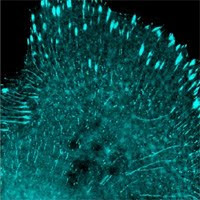The resolution of optical microscopy is limited by the Abbe limit, the diffraction limit roughly half the wavelength of the light used (e.g. green light is around 500 nm, its Abbe limit is 250 nm). Super-imaging fluorescence often involves switching fluorophores between a dark and a bright state, building a high-resolution image from many single, localized fluorophores. These technologies have become relatively well-known in the past years, including stimulated emission depletion (STED), stochastic optical reconstruction microscopy (STORM), photoactivatable localization microscopy (PALM), and a number of variations.
STED and saturated structured illumination (SSIM) require specialized microscopes to shrink the effective size of the scanning beam or to extract information from hidden patterns. Localization techniques require non-overlapping fluorophore emission by activating a small populations of fluorophores, e.g. those of photoswitchable FPs such as Dendra,mEos, or mClavGR2. Cox et al. recently reported in Nature Methods that by using Bayesian modeling they were able to utilize many overlapping fluorophores to obtain localization from blinking and bleaching. This allows high resolution imaging at 50 nm using wide field microscopy, regular FPs, and on live cells.
The technology’s novelty and focus were mostly on modeling. The authors used podosome (cytoskeletal structures associated with cell adhesion, migration, and disintegration of the extracellular matrix) danymics imaging as the first example to demonstrate the power of the new method. The software for data analysis is provided at http://3bmicroscopy.com. The technology is termed 3B analysis for Bayesian analysis of the Blinking and Bleaching. Bayesian: Bayesian probability as "a degree of plausibility of a proposition (belief in a proposition) based on the given state of knowledge," in contrast to interpreting it as a frequency or a "propensity" of some phenomenon.
Cox et al.: http://www.nature.com/nmeth/journal/vaop/ncurrent/full/nmeth.1812.html
Saturday, December 17, 2011
Localization imaging with standard fluorescent proteins on live cells—Bayesian modeling
Labels:
3B microscopy,
Bayesian,
Fluorescent proteins,
PALM,
STED,
STORM,
super imaging
Subscribe to:
Post Comments (Atom)




No comments:
Post a Comment